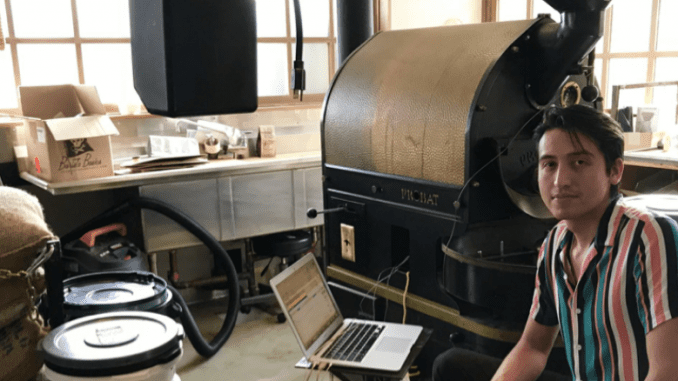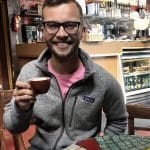
Michael Garcia is the master roaster for 10 Speed Coffee in Calabasas, Calif.; he talks to us about how his passion for coffee was hiding right under his nose.
BY JASON HUFFNAGLE
SPECIAL TO BARISTA MAGAZINE
Photo courtesy of Michael Garcia
I recently had the opportunity to sit down and chat with Michael Garcia, master roaster at Calabasas, Calif.-based 10 Speed Coffee. Our conversation not only touched on his industry experience, but also his philosophy on roasting and coffee, what he tells his trainees, and what coffee as a calling looks like for him.
This interview is lightly edited for length and clarity.
Jason Huffnagle: Tell me about what you did before getting into coffee.
Michael Garcia: I feel like I have always had a job in it, to some extent. When I was 17 I was working at a Starbucks. I mean, that’s a very retail way of going about it, but it did kind of open a door for me to learn how people viewed coffee. A lot of times people get it simply because they want the caffeine. You see others getting excited about this coffee is from this region or that region. Obviously Starbucks is very limited in terms of how different their coffee can be because of how it is roasted, but it really did show me that there was more beyond that.
JH: So that’s how you got your foot in the door?
MG: Pretty much. I mean, even if you didn’t work at a Starbucks, I feel like people went to a Starbucks, you know, when they were younger, whether it was middle school or high school, after school getting a Frappuccino. That was the segue into it.
I have always been a huge fan of music. I would always have a large group of friends that would go to Outside Lands, so we would go to San Francisco and of course during that time did we not only go to the shows, we’d also hit up all the other coffee shops in the area. So that’s how I learned about Blue Bottle, Sightglass, and Ritual. That’s what kind of got me into this idea that coffee can taste different—that there are different ways of processing it, different ways of roasting it, depending on where it is from, that can make a huge difference. So that definitely got me interested in it.
I went to school for nursing at UCLA. And while I appreciate the work that is done in it, I knew in the bottom of my heart that it was not fully for me. And it became one of these things where—I think my mom told me—sometimes it’s like right under your nose is the thing that you are probably best at, that you can be good at. At the time, like I said, I was working at a Starbucks and I think they were actually opening a roastery, a reserve concept shop in Seattle, and they were looking for people to bring over there.
So my district manager at the time suggested that I look into that—I thought about it and I realized that I didn’t want to work for Starbucks because I didn’t feel like I would have control over the profile, the roasting, and just the taste of it. So I decided to quit and started working at third-wave shops.
So the place I worked at over at The Grove was called Short Cake; I think it has closed down since, but that’s how I learned just the fundamentals of being a barista. And around that time I started working here [10 Speed Coffee] as a barista, so I was kind of juggling both. I was going here and I was driving over to West Hollywood. And yeah, when the previous roaster was going to head out, they reached out to me about taking over.
JH: So did you apprentice for a little while before you left?
MG: I did. Even before that, while I was a barista, I had a girlfriend at the time that did event planning. And she was organizing a wedding and asked me, ‘Hey I really want to do something with coffee—is there any way you can just do it?’ And I was like, ‘Uh okay, I guess I can figure it out.’
So I did research on very basic roasting, like literally you have an air-popper method and you also have a little camper fire with a nut drum. And so I decided on the nut drum method and I YouTubed it. So I bought coffee—about one pound of green beans from Sweet Maria’s—and it probably wasn’t the best. But that was my first dabble into roasting. And I created a website and created a name for this coffee called Boundary.
It was a fun little thing—I did some weddings. I did some baby showers. I did a little thing for the workers that were organizing the floats for the Rose Parade. I definitely got to do some fun things here and there.
But yeah, I did work under the master roaster during that time, Ryan. It was honestly a crash course. I was working in West Hollywood and then doing 8-10 hours here roasting with him—just learning the fundamentals of it. Once you kind of get the fundamentals of how your machine works, being aware of your air temperature, bean temperature and standard properties of coffee, then it is more based on preference, what you look for in a roast.
JH: I’m interested in hearing more about your role as master roaster. What does your day-to-day look like? It varies obviously.
MG: It varies, yeah. It’s not just about roasting. When I first came on it was that—we did not have a floor manager at the time. As things progressed, I eventually absorbed that role. So, as far as roasting, that is still a major part of my day, but I manage my baristas and do our hiring. And now we have another location in Santa Monica, so on Sundays, I am actually there for the whole day.
JH: Do you have any pointers or advice for industry folks who are more familiar with the café side of things but are looking into getting into roasting?
MG: Hmm, I don’t know how this is going to come off, but I think for me it’s also kind of like just don’t take things so seriously.
JH: That’s fair. It’s just coffee.
MG: (Laughs) That’s it. You know what, I actually tell my baristas this all the time. Because sometimes there could be interactions here and there where people are frustrated or stressed out. In the end it’s only coffee.
You can dabble. You can break things apart however much you like, but we get to work in a field where, for the most part, coffee provides a positive. People seek us out because it’s comforting.
JH: How do you approach coffee? Do you have a philosophy of roasting?
MG: I don’t know if what I am going to say is very generic, but I think for me the philosophy going in is how do I create space, how do I create a flavor profile, that if I weren’t a roaster, I would like to walk into and enjoy myself?
I tell people this all the time, but I am definitely a fanboy of Go Get ’Em Tiger. I used to live by the Larchmont location and go in as a customer. I would never talk to them about coffee and just come in and do some work. And I would just enjoy it. The people and the coffee. And for me it’s like, how do I create that experience for other people in my own particular way?
 ABOUT THE AUTHOR
ABOUT THE AUTHOR
Jason Huffnagle is a freelance writer for Barista Magazine who has worked in coffee as a barista for six years. Having left his “adult job” in the U.S. Senate, the Alaska native spent several months traveling throughout Europe. You can read about his coffee-fueled travels and other exploits by following him at @jasonhuffnagle on Twitter.

